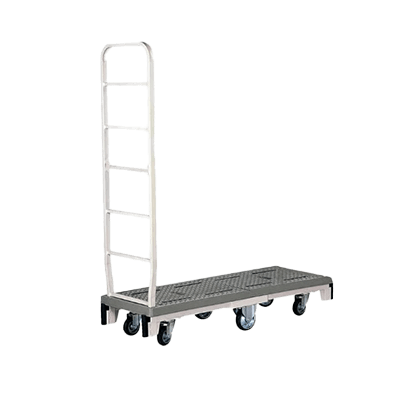What Is a 6 Wheel Trolley?

A 6 Wheel Trolley is a cart with six wheels.
The height of the hand-held fence is higher than that of a regular 4-wheel cart, and the bottom of the cart is narrower, but often long and narrow. Hand-held fences are available in one- and two-wheel types, and are shaped to be easier to pass through narrow aisles than 4-wheel carts.
The load capacity is larger than that of a 4 Wheel Trolley, about 300 kg. 6 Wheel Trolleys are equipped with casters, but when nothing is loaded on them, the casters in the middle and at one end touch the floor. When loaded with a heavy load, all casters touch the floor.
Uses of 6 Wheel Trolleys
The main uses of 6 Wheel Trolleys are as follows:
1. Luggage Transportation
Trolleys are widely used as tools for efficiently transporting luggage and heavy boxes. They are useful for transporting luggage in hotels, warehouses, stores, etc.
2. Industry and Manufacturing
Trolleys are used to transport equipment and parts in factories and manufacturing sites. They are used to move large machinery and carry parts on assembly lines.
3. Construction
Trolleys are used to move heavy materials and tools at construction sites. They are suitable for carrying concrete blocks, steel frames, tools, etc.
4. Garden and Agriculture
In addition to transporting goods, Trolleys are also used for work in gardens and farms. They are useful for transporting soil, fertilizers, agricultural products, etc.
5. Lawn Mowers and Gardening Equipment
They are sometimes used to transport and store large lawn mowers and gardening equipment.
6. Commercial and Events
Trolleys are used to transport equipment and materials at trade shows and events.
7. Medical Facilities
6 Wheel Trolleys are sometimes used in hospitals and nursing homes to transport patients and medical equipment. 6 Wheel Trolleys are longer and narrower than 4 Wheel Trolleys, making them easier to pass through doors and turn back and forth.
They are equipped with high, hand-held rails so they can be stacked with cargo. They are used in warehouses and factories as well as in narrow bookstores to transport heavy books and other items.
Principle of the 6 Wheel Trolley
The main feature of 6 Wheel Trolleys is that they are more stable than 4 Wheel Trolleys and can carry more load. They also have excellent straightness. Products with the middle caster grounded and the caster at one end floating can be rotated freely and are easy to maneuver.
A locking mechanism is provided under the handrail, and the wheels stop when you step on the lock with your foot. All casters are secured, so they are very safe. 4 Wheel Trolleys have a braking mechanism, but 6 Wheel Trolleys have a chain linkage that allows them to stop securely even on slopes.
Many products cannot be folded, but they can be nested, allowing the carts to be stored together to save space. The 73cm width, which is the standard size for doors in Japan, does not allow a 4 Wheel Trolley to pass through with a large load, but a 6 Wheel Trolley can pass through with a load.
The intermediate shelf, which is an accessory, further increases the strength of the cart and allows it to carry a large number of loads. However, the disadvantage of 6 Wheel Trolleys is that the casters on one end are floating, so they make a lot of clattering noise when loaded and moved, which can be more noisy than a 4 Wheel Trolley.
How to Select a 6 Wheel Trolley
The basic rule for selecting a Trolley is to choose a Trolley that is appropriate for the size and weight of the load to be carried. The load capacity of the cart is an important indicator and should not exceed the weight of the cargo to be transported.
The type and number of wheels should also be selected according to the environment and terrain in which the load is to be carried. Large rubber wheels are suitable for hard floor surfaces, while larger pneumatic wheels are useful on uneven terrain or in environments with many obstacles. In addition, the shape of the pedestal should match the shape of the load to be transported.
If a flat base is required, a platform cart is suitable, while a box-type cart is suitable for cubic-shaped loads. The durability of the cart is also important for long-term use. Especially for industrial applications, a sturdy cart is necessary. In addition, handles for operating the carts should be of appropriate height and shape.